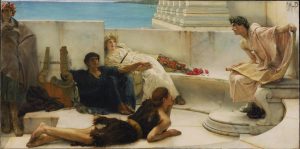Chapter 2: the Art of Narrative
 |
Sir Lawrence Alma-Tadema. (1885). A Reading from Homer. Oil on Canvas. |
“Tell me a story.” Many a parent knows this refrain from a child’s bedtime. Busy mastering language and processing the world, small children find peaceful repose in an imaginative journey led by their care givers.
People love stories. All cultures tell and treasure stories shared among their people. Indeed, cultures shape their peoples’ perspectives, attitudes, and actions through mythic narratives:
“But that’s just a myth.”
Today, the word Myth is often associated with false information. Of course, the concept of falseness depends on one’s frame of reference. For our purposes, let’s stress the role of myth in shaping the truths by which members of a culture live and interact.
Cultures have developed and shared mythic narratives as long as cultures have existed. For many thousands of years, myths were shared orally, told and re-told by generations of bards who preserved the collective mind of the people and continuously re-shaped it to encompass the culture’s learning and adapt to the conditions of the day.
Yet our idea of narrative often centers on recorded media: written text, dramas, cinema, video. But narrative recorded in written texts is a very recent development. Writing first developed about 5,000 years ago in Asia, northern Africa, and, perhaps first, in Mesopotamia.
